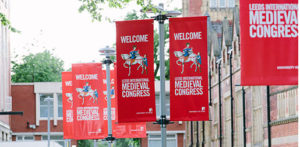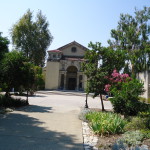The full programme of the Cult of Saints’ sessions at the 2017 IMC has now been published.
The four sessions of ‘Saints at the Margins’ explore the lower reaches of sainthood: men and women who nearly, but didn’t quite make it into sainthood; and those who just succeeded in being accepted as saints, sometimes only to sink slowly back into oblivion. This first session is focused on the difficulties of establishing a successful cult in a world already crowded with saints.
Organisers:
Bryan Ward-Perkins, Faculty of History, University of Oxford
Robert Wiśniewski, Instytut Historyczny, Uniwersytet Warszawski
Session 1224, Wednesday, 5 July, 14.15-15.45, Emmanuel Centre: Room 11
SAINTS AT THE MARGINS I: THE STRUGGLE TO LAUNCH AND MAINTAIN A CULT
Bertrand Lançon, Université de Limoges
No worship for old saints: the Carolingian construction of the Actus of the bishops of Le Mans
Pia Bockius, Freie Universität, Berlin
Texts and tangibility: Fighting oblivion in Gregory of Tours’ hagiography
Vincent Déroche, Centre d’Histoire et Civilisation de Byzance
Successes and failures in the launching of an eleventh-century cult: the contrasting cases of Symeon the Studite and Luke of Anazarbos
Session 1324, Wednesday, 5 July, 16.30-18.00, Emmanuel Centre, Room 11
SAINTS AT THE MARGINS II: UNCONVENTIONAL SAINTHOOD
Alan Thacker, Institute of Historical Research, London
Converting and sanctifying the marginal: Baptism in blood
Estelle Cronnier, Independent scholar
Figures from the Old Testament, and the cult of saints in Late Antiquity
Abigail Steed, Department of History, Durham University
Creating a Martyr: The Case of St Ælfheah
Session 1530, Thursday, 6 July, 9.00-10.30, Emmanuel Centre: Room 11
SAINTS AT THE MARGINS III: FAILED SAINTS
Bryan Ward-Perkins, The Cult of Saint Project, Oxford University
Uncertainty and anxiety in the mind of Gregory of Tours
Dave Defries, Kansas State University
Pagan, apostate or saint? The unconvincing martyrdom of William Longsword, second count of Normandy
James Cork-Webster, Durham University
Imperial peg, saintly hole: Eusebius of Caesarea on Constantine
Session 1630, Thursday, 6 July, 11.15-12.45, Emmanuel Centre, Room 11
SAINTS AT THE MARGINS IV: SAINTS, BUT BY A WHISKER
Matthieu Pignot, The Cult of Saints Project, Uniwersytet Warszawski
The mysterious origins of the cult of Torpes of Pisa
Michel Kaplan, Université Paris 1 (Panthéon-Sorbonne)
A saint with hagiography but no cult: Antony, archbishop of Thessaloniki († 843)


